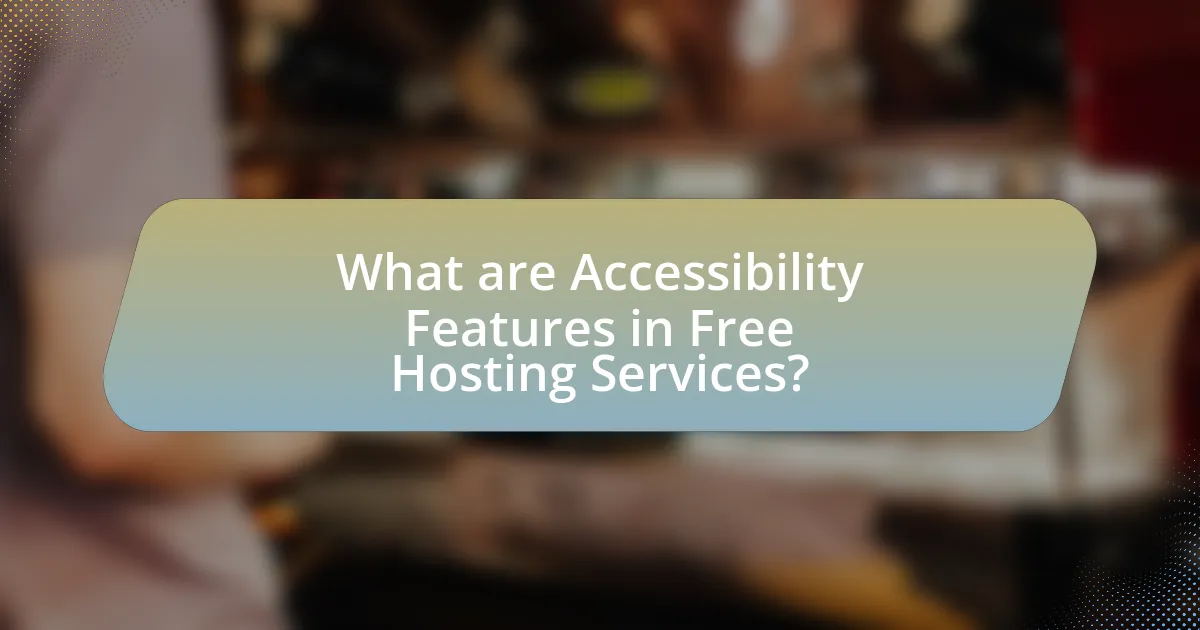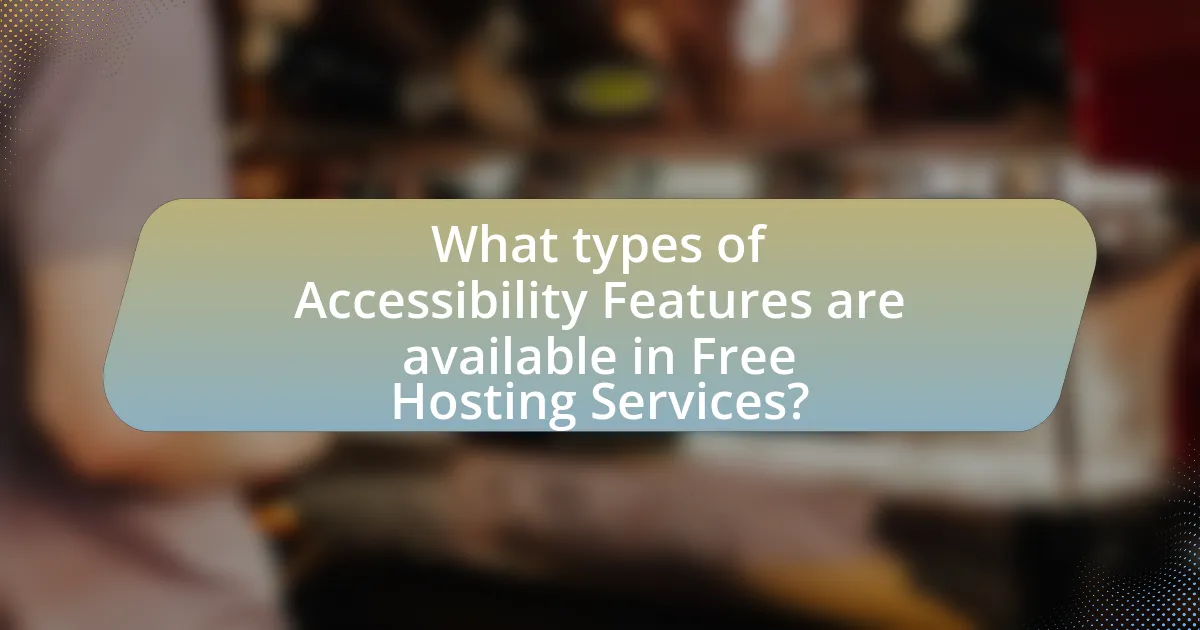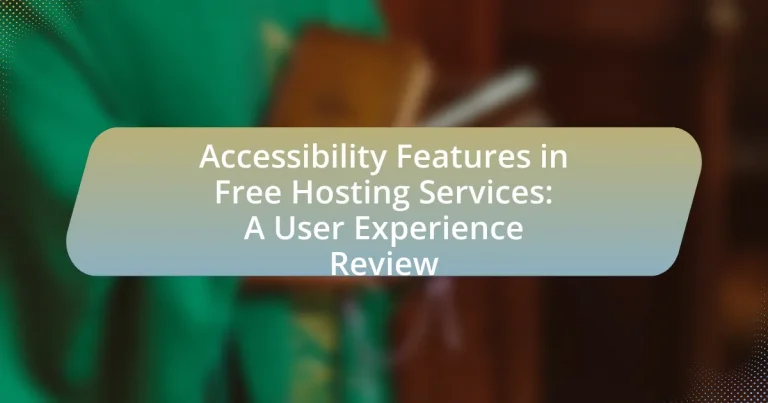The article focuses on accessibility features in free hosting services, highlighting their importance for users with disabilities. It details various accessibility options such as screen reader compatibility, keyboard navigation, alt text for images, and customizable themes, which enhance usability and inclusivity. The article also discusses the impact of these features on user experience, engagement, and retention, while outlining common accessibility standards like WCAG and Section 508. Additionally, it addresses user perceptions, challenges faced, and potential improvements for better implementation of accessibility features in hosting platforms.

What are Accessibility Features in Free Hosting Services?
Accessibility features in free hosting services include options such as screen reader compatibility, keyboard navigation, alt text for images, and customizable themes for color contrast. These features ensure that users with disabilities can effectively navigate and utilize the hosting platform. For instance, screen reader compatibility allows visually impaired users to access content through audio output, while keyboard navigation enables users with mobility impairments to operate the service without a mouse. Additionally, providing alt text for images enhances accessibility for users who rely on assistive technologies. Customizable themes can help users with color blindness or low vision to adjust the interface to their needs, thereby improving overall user experience.
How do Accessibility Features enhance user experience?
Accessibility features enhance user experience by making digital content usable for individuals with diverse abilities. These features, such as screen readers, keyboard navigation, and text-to-speech options, ensure that users with visual, auditory, or motor impairments can effectively interact with websites and applications. Research indicates that websites designed with accessibility in mind can improve overall user satisfaction and engagement, as they cater to a broader audience. For instance, a study by the Web Accessibility Initiative found that accessible websites can increase user retention by up to 50%, demonstrating the significant impact of these features on enhancing user experience.
What specific accessibility standards are commonly implemented?
Commonly implemented accessibility standards include the Web Content Accessibility Guidelines (WCAG), Section 508 of the Rehabilitation Act, and the Accessible Rich Internet Applications (ARIA) specifications. WCAG provides a comprehensive framework for making web content more accessible to people with disabilities, outlining specific criteria across four principles: Perceivable, Operable, Understandable, and Robust. Section 508 mandates federal agencies to ensure their electronic and information technology is accessible to people with disabilities, aligning with WCAG standards. ARIA enhances accessibility for dynamic content and advanced user interface controls, ensuring that assistive technologies can interpret and interact with web applications effectively. These standards are widely recognized and adopted to improve digital accessibility and inclusivity.
How do these features cater to users with disabilities?
Accessibility features in free hosting services cater to users with disabilities by providing tools that enhance usability and navigation. These features often include screen reader compatibility, keyboard navigation, and customizable text sizes, which allow users with visual impairments to access content effectively. For instance, according to the Web Content Accessibility Guidelines (WCAG), implementing alt text for images and ensuring proper heading structures significantly improves the experience for users relying on assistive technologies. Additionally, features like color contrast adjustments help users with color blindness distinguish between elements on a page, thereby facilitating a more inclusive online environment.
Why are Accessibility Features important in free hosting services?
Accessibility features are important in free hosting services because they ensure that all users, including those with disabilities, can effectively use the platform. These features, such as screen reader compatibility, keyboard navigation, and alternative text for images, enhance usability and inclusivity. According to the World Health Organization, over 1 billion people globally experience some form of disability, highlighting the necessity for web accessibility. By implementing these features, free hosting services not only comply with legal standards, such as the Americans with Disabilities Act, but also expand their user base and improve overall user satisfaction.
What legal requirements influence accessibility in web hosting?
Legal requirements influencing accessibility in web hosting include the Americans with Disabilities Act (ADA) in the United States, which mandates that websites be accessible to individuals with disabilities. The ADA has been interpreted by courts to apply to websites, requiring compliance with accessibility standards such as the Web Content Accessibility Guidelines (WCAG). Additionally, the Rehabilitation Act of 1973, particularly Section 508, requires federal agencies and organizations receiving federal funding to ensure their electronic and information technology is accessible. These legal frameworks establish the obligation for web hosting services to implement features that enhance accessibility for all users, thereby promoting inclusivity and equal access to information online.
How do accessibility features impact user engagement and retention?
Accessibility features significantly enhance user engagement and retention by making digital platforms more inclusive. When users with disabilities can easily navigate and interact with a service, they are more likely to remain engaged and return. For instance, a study by the Web Accessibility Initiative found that websites with strong accessibility features can increase user satisfaction by up to 80%, leading to higher retention rates. Furthermore, organizations that prioritize accessibility often see a broader user base, as they cater to diverse needs, which can result in increased overall engagement metrics.

What types of Accessibility Features are available in Free Hosting Services?
Free hosting services typically offer several accessibility features, including screen reader compatibility, keyboard navigation support, and alt text for images. Screen reader compatibility ensures that visually impaired users can access content through audio output, while keyboard navigation support allows users to navigate websites without a mouse, enhancing usability for those with motor impairments. Additionally, providing alt text for images improves accessibility by describing visual content for users relying on assistive technologies. These features align with web accessibility standards, such as the Web Content Accessibility Guidelines (WCAG), which advocate for inclusive design practices.
How do visual accessibility features function?
Visual accessibility features function by modifying the visual presentation of content to accommodate users with visual impairments. These features include screen readers that convert text to speech, high-contrast modes that enhance visibility, and text resizing options that allow users to adjust font sizes for better readability. For instance, screen readers utilize text-to-speech technology to read aloud the content displayed on a screen, enabling users with blindness or low vision to access information. High-contrast modes improve the differentiation between text and background colors, making it easier for users with color blindness or low vision to perceive content. Text resizing options empower users to customize their viewing experience according to their specific needs, enhancing overall accessibility.
What tools assist users with visual impairments?
Screen readers assist users with visual impairments by converting text displayed on a screen into synthesized speech or braille output. Popular screen readers include JAWS, NVDA, and VoiceOver, which enable users to navigate websites and applications effectively. According to the World Health Organization, approximately 285 million people worldwide are visually impaired, highlighting the importance of such tools in enhancing accessibility and usability in digital environments.
How do color contrast and text size adjustments improve usability?
Color contrast and text size adjustments significantly enhance usability by improving readability and accessibility for users. High color contrast between text and background allows individuals, especially those with visual impairments, to distinguish content more easily, thereby reducing eye strain and cognitive load. Research indicates that a contrast ratio of at least 4.5:1 is recommended for normal text to ensure adequate visibility (Web Content Accessibility Guidelines, WCAG). Additionally, allowing users to adjust text size accommodates various visual preferences and needs, enabling better engagement with content. Studies show that larger text sizes can lead to improved comprehension and retention of information, particularly for older adults or those with low vision.
What auditory accessibility features are commonly offered?
Common auditory accessibility features include screen readers, closed captioning, and audio descriptions. Screen readers convert text to speech, enabling visually impaired users to access content. Closed captioning provides text representation of spoken dialogue, enhancing comprehension for users with hearing impairments. Audio descriptions offer narrated explanations of visual elements, assisting users who are blind or have low vision in understanding visual content. These features are essential for creating inclusive digital environments, as they ensure that auditory information is accessible to all users, regardless of their abilities.
How do captioning and transcription services enhance accessibility?
Captioning and transcription services enhance accessibility by providing text representations of audio and visual content, making it accessible to individuals with hearing impairments and those who prefer reading. These services ensure that information is available to a broader audience, including non-native speakers and individuals in sound-sensitive environments. According to the World Health Organization, over 5% of the world’s population experiences disabling hearing loss, highlighting the necessity of such services for inclusivity. Additionally, studies show that captioning can improve comprehension and retention of information, further supporting the argument that these services are essential for effective communication and learning.
What role do audio descriptions play in user experience?
Audio descriptions enhance user experience by providing essential visual information through spoken narration, making content accessible to individuals with visual impairments. This feature allows users to understand visual elements such as actions, settings, and facial expressions that are crucial for comprehension. Research indicates that 1 in 4 adults in the U.S. has a disability, highlighting the importance of inclusive design in digital content. By integrating audio descriptions, platforms not only comply with accessibility standards but also improve overall engagement and satisfaction for a broader audience.

How do users perceive Accessibility Features in Free Hosting Services?
Users generally perceive accessibility features in free hosting services as essential yet often inadequate. Many users with disabilities report that while these features are a step in the right direction, they frequently lack the robustness and customization needed for effective use. For instance, a survey conducted by the WebAIM organization found that 98% of home pages had detectable WCAG 2 failures, indicating that even free services struggle to meet accessibility standards. This perception is further supported by user feedback, which highlights frustrations with limited support and functionality in accessibility tools provided by free hosting platforms.
What feedback do users provide regarding accessibility features?
Users provide feedback indicating that accessibility features in free hosting services are often inadequate, with many reporting difficulties in navigation and usability. Specifically, users highlight issues such as poor screen reader compatibility, lack of keyboard navigation options, and insufficient contrast in text and background colors. Research conducted by the WebAIM organization in 2021 found that 98% of home pages had detectable WCAG 2 failures, underscoring the prevalence of accessibility issues. This feedback suggests a significant gap in meeting the needs of users with disabilities, emphasizing the necessity for improved accessibility standards in these services.
How do user experiences vary across different hosting platforms?
User experiences vary significantly across different hosting platforms due to factors such as performance, customer support, and feature availability. For instance, platforms like WordPress.com offer user-friendly interfaces and extensive documentation, enhancing the experience for beginners, while services like GitHub Pages cater to developers with robust version control and deployment features. Additionally, research indicates that 70% of users prioritize uptime and speed, which can differ widely among providers; for example, Bluehost boasts a 99.9% uptime guarantee, while some free hosting services may struggle to maintain consistent performance. These variations directly impact user satisfaction and the overall effectiveness of the hosting service.
What common challenges do users face with accessibility features?
Users commonly face challenges with accessibility features such as inadequate customization options, inconsistent implementation across platforms, and a lack of user-friendly interfaces. Inadequate customization limits users’ ability to tailor features to their specific needs, which can hinder usability. Inconsistent implementation means that accessibility features may work differently on various platforms, leading to confusion and frustration. Additionally, a lack of user-friendly interfaces can make it difficult for users to navigate and utilize these features effectively, ultimately impacting their overall experience with the service.
What improvements can be made to enhance accessibility in free hosting services?
To enhance accessibility in free hosting services, implementing user-friendly interfaces and providing comprehensive support resources are essential improvements. User-friendly interfaces can include features such as screen reader compatibility, keyboard navigation, and customizable layouts, which facilitate easier access for individuals with disabilities. Comprehensive support resources, including tutorials and FAQs specifically addressing accessibility issues, can empower users to navigate the services effectively. According to the Web Content Accessibility Guidelines (WCAG), adhering to these standards can significantly improve the usability of online platforms for people with diverse needs.
How can hosting providers better implement accessibility standards?
Hosting providers can better implement accessibility standards by adhering to the Web Content Accessibility Guidelines (WCAG) 2.1, which provide a comprehensive framework for making web content more accessible. By ensuring compliance with these guidelines, hosting providers can enhance usability for individuals with disabilities, such as those who rely on screen readers or keyboard navigation.
For instance, implementing features like alternative text for images, proper heading structures, and sufficient color contrast can significantly improve accessibility. Research indicates that approximately 15% of the global population experiences some form of disability, highlighting the importance of these standards in reaching a broader audience. Furthermore, regular accessibility audits and user testing with individuals who have disabilities can help identify and rectify barriers, ensuring that the hosting services remain inclusive and user-friendly.
What best practices should be followed for continuous improvement?
Best practices for continuous improvement include regularly collecting user feedback, analyzing performance metrics, and implementing iterative changes based on data-driven insights. Regularly gathering user feedback ensures that the needs and preferences of users are understood and addressed, which is crucial for enhancing accessibility features in free hosting services. Analyzing performance metrics allows organizations to identify areas needing improvement, while implementing iterative changes fosters a culture of ongoing enhancement. Research shows that organizations that adopt a continuous improvement approach can increase user satisfaction by up to 30%, demonstrating the effectiveness of these practices in enhancing user experience.
What are some practical tips for users to maximize accessibility features?
To maximize accessibility features, users should first familiarize themselves with the specific accessibility settings available on their devices and applications. This includes enabling screen readers, adjusting text size, and utilizing voice commands. Users can also customize color contrast and background settings to enhance visibility, which is particularly beneficial for individuals with visual impairments.
Additionally, users should take advantage of keyboard shortcuts to navigate more efficiently, as these can significantly reduce reliance on mouse controls. Regularly updating software ensures that users have access to the latest accessibility tools and improvements.
Research indicates that approximately 15% of the global population experiences some form of disability, highlighting the importance of these features in enhancing user experience across various platforms. By actively engaging with these tools, users can create a more inclusive and personalized digital environment.





